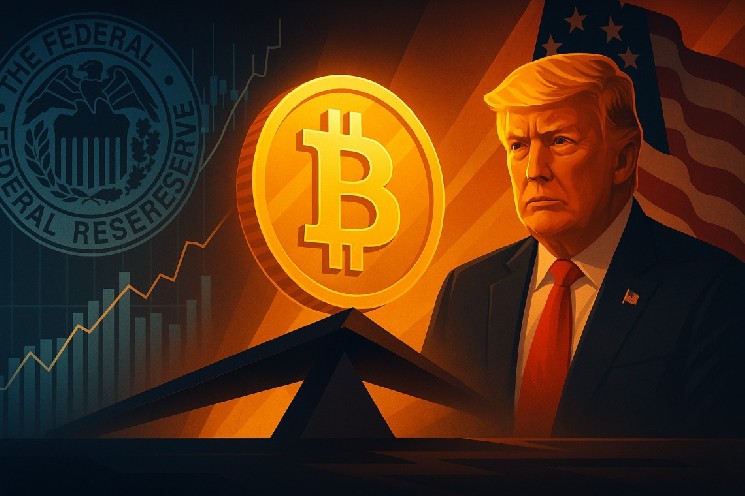The price of Bitcoin, after reaching a new all-time high in May, struggles to maintain momentum. Despite the initial euphoria following the re-election of President Donald Trump, the world’s most famous cryptocurrency is now in a phase of uncertainty, closely tied to the decisions of the Federal Reserve and the economic tensions surrounding the US dollar.
Trump recently announced that the choice of the next president of the Fed will be made public “very soon.” During an interview aboard Air Force One, reported by Reuters, the president reiterated his position:
“If we had a good Fed president, they would lower the rates, and if inflation appeared in a year or two, then they would raise them again.”
Kevin Warsh in pole position for leading the Fed
Among the most quoted names for the succession of Jerome Powell stands out that of Kevin Warsh, former governor of the Fed, currently leading in the predictions on the forecasting platform Polymarket, powered by blockchain technology. Trump described Warsh as “highly regarded,” suggesting that his appointment could be imminent.
Warsh recently participated in a panel on monetary policy at the Hoover Institution of Stanford University, where he outlined his vision: according to him, the Fed could lower rates if it reduced its balance sheet. “If money printing could be stopped, we could have lower monetary policy rates,” he stated.
The relationship between interest rates and Bitcoin
The analysts of the crypto market, particularly those from the exchange Bitfinex, are closely watching the moves of the Fed. In a comment sent via email, they stated that a potential rate cut “would be positive for risky assets like Bitcoin.” According to their forecasts, if Bitcoin manages to maintain support above 105,000 dollars, it could aim for a range between 120,000 and 125,000 dollars in the month of June.
However, they emphasize that it will not only be the labor market influencing the Fed’s decision, but a combination of factors could lead to a rate cut more quickly than expected.
Inflation and trade tariffs: a delicate balance
The debate on interest rates is made even more complex by the trade policies of the Trump administration. The Fed has indicated that the global tariffs imposed by the president could cause a spike in inflation, which is why it decided to keep rates unchanged during the June and July meetings. The market remains divided on the possibility of a change in September, as indicated by the CME FedWatch tool.
The next week will be crucial: the data on the consumer price index (CPI) in the United States could show a new increase in inflation, after a period of slowdown in the first months of 2025.
Pressures on the Fed: Trump insists on a rate cut
Trump has renewed his call for the Fed to cut interest rates, which have remained stable for months after the start of the reduction cycle in September. In April, the White House had confirmed that the president was considering the possibility of removing Powell for his reluctance to cut rates, although Trump later clarified that he does not intend to replace him before the end of his term, scheduled for next year.
According to Nicholas Hyett, investment manager at Wealth Club, Powell’s position remains precarious:
“With rate cuts becoming less and less likely, the Fed chairman can expect to remain in the president’s crosshairs.”
Hyett also commented on the employment data, stronger than expected, which strengthen the Fed’s position in keeping rates unchanged. However, this scenario complicates the fiscal plans of the Trump administration, which aims to support the real economy through its ambitious spending plan known as “Big Beautiful Bill”.
Elon Musk and the fear of a dollar collapse
To further complicate the picture, the position of billionaire Elon Musk is added, who reportedly expressed concerns about a possible collapse of the dollar. Although his statements were made discreetly, their impact on the market was significant, further fueling speculations about the future of the US currency and the role of cryptocurrencies as an alternative.
The reference to a potential “37 trillion dollar time bomb” has shaken investors, increasing the perception of systemic risk linked to public debt and the financial stability of the United States.
Bitcoin between hopes and uncertainties
In this context, Bitcoin is suspended between hopes and fears. On one hand, a rate cut could represent a catalyst for a new bull phase. On the other hand, political uncertainty, trade tensions, and inflation make the picture extremely volatile.
The cryptocurrency market remains in anticipation, with eyes fixed on the White House and the Federal Reserve. The appointment of the new Fed chairman and the upcoming monetary policy decisions will be crucial for the future of Bitcoin and the entire crypto ecosystem.
In the meantime, investors continue to monitor every signal coming from Trump, the Fed, and influential figures like Musk, aware that in such a fluid context, even a single statement can shift the balances of the global market.
Read the full article here

